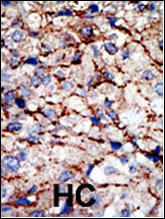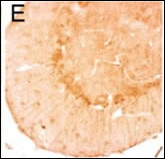KMT4 / Dot1L Antibody (N-Term)
Purified Rabbit Polyclonal Antibody (Pab)
- SPECIFICATION
- CITATIONS: 1
- PROTOCOLS
- BACKGROUND

Application
| IHC-P, E |
|---|---|
| Primary Accession | Q8TEK3 |
| Other Accession | NP_115871 |
| Reactivity | Human |
| Host | Rabbit |
| Clonality | Polyclonal |
| Isotype | Rabbit IgG |
| Calculated MW | 164856 Da |
| Antigen Region | 87-117 aa |
| Gene ID | 84444 |
|---|---|
| Other Names | Histone-lysine N-methyltransferase, H3 lysine-79 specific, DOT1-like protein, Histone H3-K79 methyltransferase, H3-K79-HMTase, Lysine N-methyltransferase 4, DOT1L, KIAA1814, KMT4 |
| Target/Specificity | This KMT4 / Dot1L antibody is generated from rabbits immunized with a KLH conjugated synthetic peptide between 87~117 amino acids from the N-terminal region of human DOT1L. |
| Dilution | IHC-P~~1:50~100 |
| Format | Purified polyclonal antibody supplied in PBS with 0.09% (W/V) sodium azide. This antibody is prepared by Saturated Ammonium Sulfate (SAS) precipitation followed by dialysis against PBS. |
| Storage | Maintain refrigerated at 2-8°C for up to 2 weeks. For long term storage store at -20°C in small aliquots to prevent freeze-thaw cycles. |
| Precautions | KMT4 / Dot1L Antibody (N-Term) is for research use only and not for use in diagnostic or therapeutic procedures. |
| Name | DOT1L (HGNC:24948) |
|---|---|
| Synonyms | KIAA1814, KMT4 |
| Function | Histone methyltransferase. Methylates 'Lys-79' of histone H3. Nucleosomes are preferred as substrate compared to free histones (PubMed:12123582). Binds to DNA (PubMed:12628190). |
| Cellular Location | Nucleus. |

Provided below are standard protocols that you may find useful for product applications.
Background
Similar to acetylation and phosphorylation, histone methylation at the N-terminal tail has emerged as an important role in regulating chromatin dynamics and gene activity. Histone methylation occurs on arginine and lysine residues and is catalyzed by two families of proteins, the protein arginine methyltransferase family and the SET-domain-containing methyltransferase family. Five members have been identified in the arginine methyltransferase family. About 27 are grouped into the SET-domain family, and another 17 make up the PR domain family that is related to the SET domain family. The retinoblastoma protein-interacting zinc finger geneRIZ1 is a tumor suppressor gene and a FOUNDING member of the PR domain family. RIZ1 inactivation is commonly found in many types of human cancers and occurs through loss of mRNA expression, frame shift mutation, chromosomal deletion, and missense mutation. RIZ1 is also a tumor susceptibility gene in mice. The loss of RIZ1 mRNA in human cancers was shown to associate with DNA methylation of its promoter CpG island. Methylation of the RIZ1 promoter strongly correlated with lost or decreased RIZ1 mRNA expression in breast, liver, colon, and lung cancer cell lines as well as in liver cancer tissues.
References
Feng, Q., et al., Curr. Biol. 12(12):1052-1058 (2002).
If you have used an Abcepta product and would like to share how it has performed, please click on the "Submit Review" button and provide the requested information. Our staff will examine and post your review and contact you if needed.
If you have any additional inquiries please email technical services at tech@abcepta.com.














 Foundational characteristics of cancer include proliferation, angiogenesis, migration, evasion of apoptosis, and cellular immortality. Find key markers for these cellular processes and antibodies to detect them.
Foundational characteristics of cancer include proliferation, angiogenesis, migration, evasion of apoptosis, and cellular immortality. Find key markers for these cellular processes and antibodies to detect them. The SUMOplot™ Analysis Program predicts and scores sumoylation sites in your protein. SUMOylation is a post-translational modification involved in various cellular processes, such as nuclear-cytosolic transport, transcriptional regulation, apoptosis, protein stability, response to stress, and progression through the cell cycle.
The SUMOplot™ Analysis Program predicts and scores sumoylation sites in your protein. SUMOylation is a post-translational modification involved in various cellular processes, such as nuclear-cytosolic transport, transcriptional regulation, apoptosis, protein stability, response to stress, and progression through the cell cycle. The Autophagy Receptor Motif Plotter predicts and scores autophagy receptor binding sites in your protein. Identifying proteins connected to this pathway is critical to understanding the role of autophagy in physiological as well as pathological processes such as development, differentiation, neurodegenerative diseases, stress, infection, and cancer.
The Autophagy Receptor Motif Plotter predicts and scores autophagy receptor binding sites in your protein. Identifying proteins connected to this pathway is critical to understanding the role of autophagy in physiological as well as pathological processes such as development, differentiation, neurodegenerative diseases, stress, infection, and cancer.


